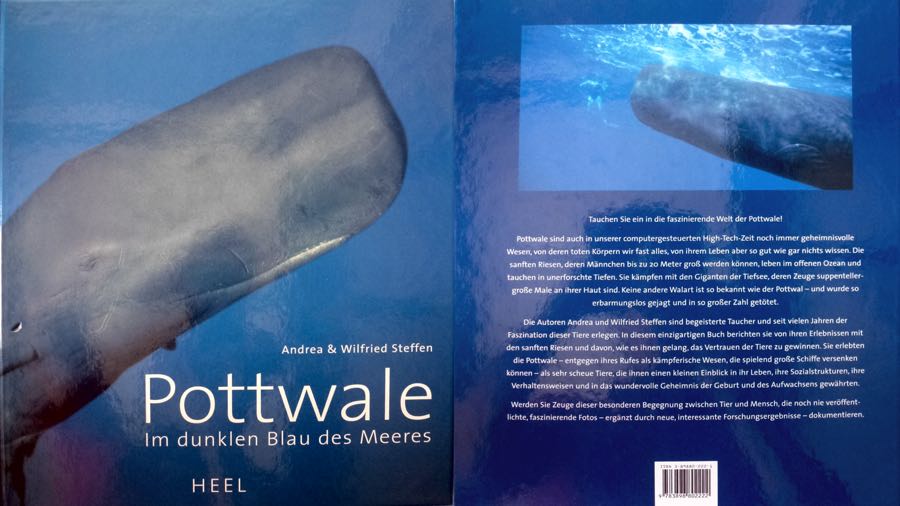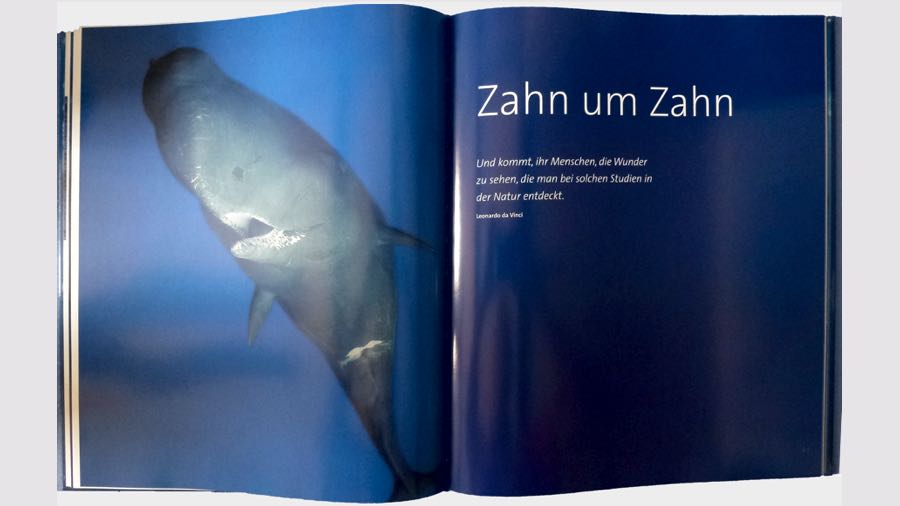
Sperm whales – in the dark blue of the sea
Excerpt from our chapter: Love and sex
Sexual maturity
Last year, for example, we observed a large adult male sperm whale that had only arrived a few days ago and had not yet joined any companions. During the morning we saw him jump out of the water twice, which seemed very impressive given his size. In the afternoon we found our big, strong, lonely sperm whale not so lonely anymore. He had gathered a proud group of 11 sperm whales around him. Including many females, some young sperm whales and also a baby. At approximately 17 meters, it was by far the most impressive sperm whale in this family. Did he attract the attention of the other whales with his jumps in the morning? Did he perhaps even call them together? The fact is that we saw him swimming alone days before and in the morning, but after the jumps he had a whole family gathered around him.
Of course, he was only interested in females that were ready to mate, because that was the reason for his long journey from the Arctic here to Dominica. He wants to mate, but this isn't very easy with a full-grown bull of his size.
In male sperm whales, puberty begins at an average age of 9 years, when they have reached a size of 9 - 10 meters. However, spermatogenesis, or sexual maturity, is not completed until the child is around 20 years old.
However, sexual maturity in female sperm whales begins much earlier. With an average age of 9 years and a height of 9 meters, they are already taking part in reproduction. Sexually mature females usually ovulate in spring (January to July). Off the Azores, for example, the peak of mating has been observed between March and May.
Sexual organs
The size of the testicles is also important in other whale species. In males that fight for a particular female and drive their rivals away, such as humpback whales, the testicles are relatively small. In males, which mate with many females as often as possible and do not hinder their rivals, as has been observed in right whales, the testicles are much larger.
The erectile tissue of the penis is surrounded by elastic and collagenous tissue, which is permeated by blood vessels and nerves and covered by a thick layer of muscle packages. Camels also have a comparable muscular penis. However, the corpora cavernosa portion of the relatively long and mobile penis is very small compared to other mammals.
The female sexual organs are typical of mammals. The ovaries are located in approximately the same place as the testicles in male animals. The uterus is comparable to those of carnivores and pigs, but develops slightly differently in toothed and baleen whales. In immature whales, the uterus still consists of two so-called uterine horns that are identically formed.
However, later in toothed whales the left uterine horn develops wider because that is where the fetus generally develops. In baleen whales, however, the fetus can develop in both uterine horns.
The fertilized egg implants very loosely in the mucous membrane and therefore has the advantage that there is only minimal bleeding after birth. The relatively long cervix has a thick, muscular wall and extends into the interior of the vagina. The vagina merges into an elongated fold (vulva) with two pairs of lips, which lies directly in front of the anus.
Breast milk
For example, the birth date of a pregnant dolphin can be predicted based on the distance between the suckling slits. In dolphins kept in dolphinariums, the distance between the nursing slits of pregnant females is measured daily shortly before birth. A distance of 40 mm is normal. But when birth is imminent, the distance is 60 mm. In addition to the body temperature dropping from the normal 98 - 99o Fahrenheit (36.7o - 37.2o Celsius) to 96o Fahrenheit (35.6o Celsius), these are sure signs that birth is imminent.
Pairing
But how does an adult sperm whale bull, 18 - 20 meters long, manage to find the even further away vagina with his two meter long penis, which is about 10 - 12 meters away from his eyes, in order to mate? And all this without hands?
As already described above, the whale's penis is moved with the help of many muscles. This explains its movements, but not how these movements are coordinated.
In 1994, Günther Behrmann wrote an extremely interesting paper on the “movement coordination of the penis during copulation”. For this purpose, he examined porpoises and his results were unique.
After successful reproduction, the young are born after a gestation period of approximately 15 months. Sperm whales usually only give birth to a single calf every four to six years. If you now consider that only 10-15% of sexually mature males participate in reproduction and because of the long gestation and breastfeeding period only about 35% of sexually mature female sperm whales are ready to mate, the pregnancy rate is the lowest in the entire animal kingdom.
The hunting of sperm whales actually has a significant negative impact. After 15 months a single calf is born and after at least 3 - 4 years the mother would give birth again. Today it only takes humans 20 minutes to kill a single sperm whale. Of course, this is only for scientific purposes.
This method is unique to us humans.






 Die Autoren Andrea und Wilfried Steffen sind begeisterte Taucher und seit vielen Jahren der Faszination dieser Tiere erlegen. In diesem einzigartigen Buch berichten sie von Ihren Erlebnissen mit den sanften Riesen und davon, wie es ihnen gelang, das Vertrauen der Tiere zu gewinnen. Sie erlebten die Pottwale – entgegen ihres Rufes als kämpferische Wesen, die spielend große Schiffe versenken können- als scheue Tiere, die ihnen einen kleinen Einblick in ihr Leben, ihre Sozialstrukturen, ihre Verhaltensweisen und in das wundervolle Geheimnis der Geburt und des Aufwachsen gewährten.
Die Autoren Andrea und Wilfried Steffen sind begeisterte Taucher und seit vielen Jahren der Faszination dieser Tiere erlegen. In diesem einzigartigen Buch berichten sie von Ihren Erlebnissen mit den sanften Riesen und davon, wie es ihnen gelang, das Vertrauen der Tiere zu gewinnen. Sie erlebten die Pottwale – entgegen ihres Rufes als kämpferische Wesen, die spielend große Schiffe versenken können- als scheue Tiere, die ihnen einen kleinen Einblick in ihr Leben, ihre Sozialstrukturen, ihre Verhaltensweisen und in das wundervolle Geheimnis der Geburt und des Aufwachsen gewährten.
 Werden Sie Zeuge dieser besonderen Begegnung zwischen Tier und Mensch, dokumentiert mit noch nie veröffentlichten, faszinierenden Fotos und ergänzt durch neue, interessante Forschungsergebnisse.
Werden Sie Zeuge dieser besonderen Begegnung zwischen Tier und Mensch, dokumentiert mit noch nie veröffentlichten, faszinierenden Fotos und ergänzt durch neue, interessante Forschungsergebnisse.
 Spannend und einfühlsam lassen sie die Leser an ihren hautnahen Walbegegnungen teilnehmen. Mit einmaligen Aufnahmen, vor allem von den drei Großen: den Blau-, Buckel- und Pottwalen, belegen sie ihre in weltweiten Beobachtungen gesammelten Erkenntnisse. Einzigartig ihre jahrelange Begleitung der „Group of Seven“, einer Gruppe von Pottwalen, den größten Raubtieren der Erde, bei der sie das Heranreifen eines Jungbullen von der Geburt an erleben konnten.
Spannend und einfühlsam lassen sie die Leser an ihren hautnahen Walbegegnungen teilnehmen. Mit einmaligen Aufnahmen, vor allem von den drei Großen: den Blau-, Buckel- und Pottwalen, belegen sie ihre in weltweiten Beobachtungen gesammelten Erkenntnisse. Einzigartig ihre jahrelange Begleitung der „Group of Seven“, einer Gruppe von Pottwalen, den größten Raubtieren der Erde, bei der sie das Heranreifen eines Jungbullen von der Geburt an erleben konnten.
 Tauchen Sie ein in die Welt der Wale. Erleben sie Großaufnahmen aus allernächster Nähe und erfahren sie interessante Forschungsergebnisse aus dem geheimnisvollen Leben dieser Meeresriesen.
Tauchen Sie ein in die Welt der Wale. Erleben sie Großaufnahmen aus allernächster Nähe und erfahren sie interessante Forschungsergebnisse aus dem geheimnisvollen Leben dieser Meeresriesen.